Steve Cable provides a biblical understanding of Islam’s holy book, drawing on James White’s book What Every Christian Needs to Know About the Qur’an {1}. Christians interacting with Muslims will benefit from a basic understanding of the development and the teaching of the Qur’an.
Introduction and Background
Beginning with the basics, we need to understand how the Qur’an came into our possession and how it is viewed by most Muslims. The founder of Islam, Muhammad, was born in Mecca around AD 570 and began to receive instruction leading to the religion of Islam at the age of 40 in AD 610. “The classical belief is that while [the Qur’an’s] entirety was “sent down” in one night, the Night of Power, but Muhammad himself received it piecemeal over twenty-two years.”{2} Muhammad did not receive a written version as Joseph Smith claimed to have received for the Book of Mormon. Rather he memorized what was told him by the Angel Gabriel and passed it on to certain followers.
The popular Muslim belief is summarized in a recent guide to Islam as follows: “The Qur’an is the literal word of God, which He revealed to His Prophet Muhammad through the Angel Gabriel. It was memorized by Muhammad, who then dictated it to his Companions. They, in turn, memorized it, wrote it down, and reviewed it with the Prophet Muhammad. . . . Not one letter of the Qur’an has been changed over the centuries.”{3}
“From the position of Sunni Islamic orthodoxy, the Qur’an is as eternal as Allah himself. It is the very Word of God, without even the slightest imperfection. The finger of man has no place in it, as the book held reverently in the hand today is an exact copy of a tablet in heaven upon which the Qur’an has been written from eternity past.”{4}
How this view holds up to a critical review of the history of Muhammad and the early days of Islam following his death will be addressed later in this document. For now it is important to understand that to a devout Muslim, the Qur’an in its original Arabic is above analysis and above question, for it is a matter of faith that it has been perfectly transmitted and maintained. Note the Qur’an exists only in Arabic. Even though most Muslims depend upon a translation for their access to the teachings of the Qur’an, Muslims still would say the Qur’an itself is not translatable and the public prayers must also be done in Arabic.
It is interesting to realize that the Qur’an in multiple places states that Allah “sent down the Torah and the Gospel” as works that serve as guidance to mankind. One cannot help but wonder, why God would send down the Torah and the Gospels when the Qur’an existed from eternity past and according to Muslim thought supersedes and corrects misconceptions men developed from reading these earlier texts. Why didn’t God protect the Gospels in the same way as the Qur’an?
In what follows, we will look at where teachings of the Qur’an are counter to the truth of the Bible and to the historical facts. We will also consider how the current Qur’an came into existence, asking why the creator of the world would pass down his truth in such an uncontrolled fashion.
The Qur’an and Biblical Beliefs
Most Muslims, if they know anything about Christianity, will point to three primary problems with our faith:
1. the Trinity,
2. the resurrection of Jesus, and
3. the corruption of the Scriptures.
Is there anything taught in the Qur’an that causes them to reject the Christian concept of trinity?
In his book, James White describes the key Islamic belief in this way, “Ask any sincere follower what defines Islam, and they will answer quickly tawhid, the oneness of Allah, as expressed in Islam’s great confession, “I profess that there is only one God worthy of worship and Muhammad is His messenger.” . . . Without tawhid, you have no Islam.”{5}
Interestingly, the word tawhid in that form does not appear in the Qur’an just as the word trinity does not appear in the Bible. They are words to describe a concept clearly taught in those two books. The difference between these two words is a major difference between these religions. The Islamic concept of tawhid is that Allah has only and can only exist in one form, the creator of the universe. The Christian understanding is that the one God is expressed in three ways or persons, the Father, the Son and the Holy Spirit. All the persons of God were involved in the creation of this universe and reflect the full nature of God. The Bible is very clear that the Trinity is one God as shown for example in 1 Corinthians 8:4, 6:
“There is no God but one . . . for us there is but one God, the Father, from whom are all things and we exist for Him; and one Lord, Jesus Christ, by whom are all things, and we exist through Him.”
In Islam, the most feared of all sins is called shirk, associating anyone, or anything with Allah. A person who dies in this state of idolatry cannot be forgiven. In Islamic thought, Allah is free to forgive any other sin if he so desires, but he will not forgive anyone who dies in idolatry.
This teaching causes the Trinity to become an unforgivable sin for Christians. “Many Muslims believe that the doctrine of the Trinity and, in particular, the worship of Jesus is an (unforgivable) act of shirk. This has led many of them to conclude that Christians, as a group, are bound for hell.”{6}
The Qur’an attempts to address the Trinity but does it show knowledge of the concept so that the criticisms offered are accurate and meaningful? “The reason for the question is self-evident: If the Qur’an is the very words of Allah without admixture of man’s insights or thoughts, then it would follow inevitably that its representations will be perfectly accurate and its arguments compelling.”{7}
What does the Qur’an say about the Trinity? First, it holds up monotheism as the correction for the false Christian claim of the “three.” By holding to this concept of the “three,” Christians are actually polytheists, denying that God is one. The author of the Qur’an does not understand that Christians are saying there is one God who manifests in three distinct forms or persons, the Father, the Son and the Holy Spirit. But the misunderstanding goes much further than this. The Qur’an is very clear that the “three” are the Father, the Son, and Mary. As stated in Surah 5:116,
And when Allah said: “O Jesus son of Mary! Did you say to mankind: ‘Take me and my mother for two gods other than Allah?’” He said: “Transcendent are you! It was not mine to say that of which I had no right. . .”
And this view is reiterated in the Islamic commentaries, the hadith. “Nothing in the Qur’anic text actually addresses the essence of Christian faith, even though it is painfully clear the author thought he was doing so.”{8}
White believes this distinction helps us respond to the oft-asked question, “Is Allah the same god as Yahweh?” Although Muslims make reference to the one God of Abraham, they deny the witness of the incarnation and the resurrection. Thus denying the entirety of the Christian faith. “If worship is an act of truth, then Muslims and Christians are not worshiping the same object. We do not worship the same God.”{9}
So, we see the Qur’an misrepresents the Christian doctrine of the Trinity and relegates Allah to a lower status than omnipotent God by declaring that Allah is not capable of appearing in multiple forms.
The Qur’an, Jesus and Salvation
As we consider what Muslims are taught in the Qur’an, we next look at the second stumbling block in their view of Christianity: the crucifixion and resurrection of Jesus Christ the Son of God.
The Qur’an has quite a bit to say about Jesus as a prophet of God, specifically stating He was not God and was not crucified. The name of Jesus appears 25 times in the Qur’an, almost always as Isa ibn Mariam, i.e. Jesus the son of Mary. Jesus is presented as the result of a miraculous virgin birth. In the Qur’an, Surah 3:47, it is written, “She said, My Lord! How can I have a child, when no man has touched me? He replied, “such is the will of Allah. He creates what He will. When He decrees a thing He only says: ‘Be!’ and it is.”{10}
The question of how Jesus came to be is an important topic for comparison. First, we see the Qur’an says that Allah created Jesus by declaring His existence and having Him born of a virgin. Second, we understand that the author of the Qur’an believed Christians teach that Jesus came into being as the child of a physical, sexual union between God and Mary. Third, Christianity actually teaches that Jesus was the preexistent creator of the universe (John 1:1-3, Colossians 1:16-17), always and fully God, who became fully man being born of a virgin. Note that the primary difference between the Qur’an’s view of Jesus’ birth and a biblical view of Jesus’ birth is not the role of Mary, but rather the Qur’an says that Jesus was created at His human conception and the Bible clearly states that Jesus is eternal and was not created but rather took on a new form at his birth:
Although He existed in the form of God, did not regard equality with God a thing to be grasped, but emptied Himself, taking the form of a bond-servant, and being made in the likeness of men. Being found in appearance as a man, He humbled Himself by becoming obedient to the point of death, even death on a cross. (Philippians 2:6-8)
The words attributed to Jesus in the Qur’an, beginning with words spoken from the crib, are not found in any source from the 1st through 5th centuries. “But the Muslim understanding is that no such historical foundation is needed for lengthy portions of narrative for its words to be true. This is the Qur’an. It has been preserved. For the large majority, that ends the discussion, even when the same believers will then embrace historical criticism to question the value of His words in the Gospels.”{11}
When it comes to the cross, the Qur’an stands firmly and inalterably against the mass of historical evidence and the almost universal view of the populace of itsday. This Qur’anic view is not sprinkled throughout the teaching, but rather appears in only one verse, namely Surah 4:157—
“They slew him not, nor crucified him, but it appeared so to them; and those who disagree concerning it are in doubt thereof; they have no knowledge of it except the pursuit of a conjecture; [but] certainly they slew him not. But Allah raised him up to Himself.”
This verse stands alone in the Qur’an and surprisingly without commentary in the hadith literature as well. This verse, written six hundred years after the events, in a place far removed from Jerusalem, takes a position counter to the gospel texts from the first century and counter to six centuries of Christian teaching. In more recent times, various Muslim apologists have surmised various tales to build upon this one verse. For example, some Muslims believe that someone else died on the cross and Jesus fled to India to continue his ministry there.{12} Regardless of what unsubstantiated fairy tales one conjures up to support its claim, this verse is based on no historical knowledge of the events surrounding the death and resurrection of Jesus.
“This suggests the author did not have even the slightest knowledge of the centrality of God’s redeeming act in Christ on the cross. . . The Qur’an places itself, and all who would believe in it, in direct opposition not only to the Gospels but also everything history itself says on the subject. The question must be asked: Who, truly, is following mere conjecture here? Those who were eyewitnesses on the Hill of the Skull outside Jerusalem? Or the author of the Qur’an, more than half a millennium later?”{13}
Without the cross, salvation in the Qur’an comes through an unknowable mixture of predestination, good works, and the capricious will of Allah. “In Islam, forgiveness is an impersonal act of arbitrary divine power. In Christianity, forgiveness is a personal act of purposeful and powerful yet completely just divine grace.”{14}
One cannot attribute these differences between the Qur’an and the New Testament to a minor corruption of the biblical text as they reflect the core themes of these books.
Corrupting the Gospels
As discussed above, most Muslims have been taught there are three primary problems with our faith: the Trinity, the resurrection of Jesus, and the corruption of the scripture. We have dealt with the Trinity and the resurrection of Jesus. Now let us turn to the corruption of scripture.
Most Muslims will affirm to you that the Christian scriptures cannot be relied upon because they have been changed and corrupted over the years and do not reflect the true message of Jesus. But is this affirmation what is taught by the Qur’an, and does it have any basis other than hearsay?
The Qur’an is very clear that the messages sent to the prophets of the Bible are to be believed. For example, Surah 3:84 says, “We believe in Allah . . . and that which was sent down to Abraham and Ishmael and Isaac and Jacob and the tribes; and that which was given to Moses and Jesus and the Prophets from their Lord. We make no distinction between any of them, and to Him we have surrendered.” Or as stated in a hadith, “Therefore, faithful Muslims believe in every Prophet whom Allah has sent and in every Book He revealed, and never disbelieve in any of them.”{15}
Very clearly, the Qur’an states that what was given to the Old Testament prophets and to Jesus was the truth of God. It is not just the prophets themselves who were from the Lord, for the Qur’an states that Allah “sent down the Torah and the Gospel” as works that serve as “guidance to mankind.” If this is the case, why do Muslims not interpret the Qur’an in light of the truth from the Gospels, assuming that Allah’s truth never changes?
In contrast, it is a virtual pillar of Islamic orthodoxy to hold that the Bible has undergone significant revisions so much as to make them totally unreliable and thus, useless to a modern day Muslim. As James White puts it, “Muslims around the world are taught that the Jews and the Christians altered their Scriptures, though there is no agreement as to when this took place. If anything unites Islamic apologists, it is the persistent assertion of Qur’anic perfection in contrast to the corrupted nature of the Bible, particularly the New Testament.”{16}
This position certainly makes sense from a human perspective. For if one takes the position presented by the Qur’an that we are to believe every word of the Bible, then the huge differences between the theology of the New Testament and the theology of the Qur’an leave one little choice: either reject the Qur’an as not from God, or assume that all of the differences are the result of some massive corruption of the message of the Bible. The normal assumption taught to Muslims today is this corruption happened early on, perhaps even with the apostle Paul.
However, the preponderance of verses in the Qur’an which address this issue point to the corruption as being a distortion of the meaning (not the words) of the text. One example is found in Surah 3:78, “And there is a party of them who distort the Book with their tongues, that you may think that what they say is from the Book, when it is not from the Book.” As White observes, “We must conclude that the now predominant claim of the biblical texts themselves, having undergone major alteration and corruption, is a later polemical and theological perspective not required by the Qur’anic text itself. It comes not from the positive teachings of Muhammad but through the unalterable fact of the Qur’anic author’s unfamiliarity with the actual biblical text.”{17}
As noted by a Christian, Al-Kindi, writing to a Muslim around AD 820, “The situation is plain enough; you witness to the truth of our text—then again you contradict the witness you bear and allege that we have corrupted it; this is the height of folly.”{18}
In Surah 5:47, we are urged as Christians to judge by what Allah has revealed in the Gospels. If this admonition has any meaning at all, it must assume that Christians had access to a valid gospel in the 7th century during the life of Muhammad. What Christians had as the Gospels in the 7th century is what we have as the Gospels today. In fact, “each canonical gospel we read today we can document to have existed in that very form three centuries before Muhammad’s ministry. A Christian judging Muhammad’s claims by the New Testament and finding that he was ignorant of the teachings of the apostles, ignorant of the cross, the resurrection . . . and meaning of the gospel itself, is simply doing what the Qur’an commands us to do in this text.”{19}
Thus, while modern Muslims claim the Bible is corrupt and unreliable, the Qur’an appears to teach that the scriptures available to Jews and Christians during Muhammad’s day were correct and should be followed; as long as one did not reinterpret the meaning into something that was not really said. However, doing so would lead one to the conclusion that the Qur’an was written by someone who was not knowledgeable concerning Jewish and Christian scripture.
The Perfection of the Qur’an
As noted earlier, one of the primary objections Muslims voice toward Christianity is their belief that our Scriptures have been changed and corrupted while the Qur’an in Arabic is exactly the words given to Muhammad fourteen hundred years ago. Does this belief stand up to impartial scrutiny?
The modern Muslim view of the Qur’an does not allow for the critical examination of sources and variations as has been done for the New Testament. Many bible scholars such as Dallas Theological Seminary professor, Daniel Wallace{20}, point out that the large number of ancient manuscripts from different locations and times give us a richness of sources allowing us to identify the original text of the Christian New Testament with a high degree of confidence. Muslims on the other hand are relying on a specific follower, Uthman the third Caliph, who was purported to have assimilated the correct version and to have ordered the destruction of all other versions.
If the Qur’an is a perfect representation of the message from Allah, what accounts for the differences in multiple accounts of the same story recorded in the Qur’an? For example, four different Surahs contain the story of Lot in Sodom. Each recounting of the story is different from the others even when quoting what Lot said to the Sodomites. Thus we have Muslims pointing to differences in accounts among the Gospels but ignoring accounts of the same events throughout the Qur’an which differ in detail, order, and content.
When we find this type of variation in the Gospels, we recognize that each gospel was written by a different author with a different perspective inspired by the Holy Spirit. But if the Qur’an was preexistent in heaven and given to one man by one angel, one would not expect these types of variants. But as James White notes, “We could provide numerous examples of parallel passages all illustrating with clarity that the serious Muslim exegete must face the reality that the Qur’anic text requires exegesis and harmonization.”{21}
In addition to these troubling passages recounting different versions of the same events, we also find legendary stories about the life of Jesus which do not appear in any of the known accounts from the first century. White points out, “The Qur’an fails to make any differentiation between what is clearly legendary in character and what is based on the Hebrew or the Christian Scriptures. Stories that developed centuries after the events they pretend to describe are coupled directly with historically based accounts that carry serious weight and truth content. . . . This kind of fantastic legendary material is hardly the kind of source that can be trusted, and yet the Qur’an’s author shows not the slightest understanding of its nature and combines them with historical materials.”{22}
In addition to the inconsistencies in retelling stories and the incorporation of legends generated centuries after the actual events, we also should consider whether the current Qur’an is the perfectly accurate version of the earliest version supposedly shared verbally by Muhammad with certain followers. The common Islamic claims are strong and clear:
“The Qur’an is the literal word of God, which He revealed to His Prophet Muhammad through the Angel Gabriel. It was memorized by Muhammad, who then dictated it to his Companions. They, in turn memorized it, wrote it down, and reviewed it with the Prophet Muhammad . . . Not one letter of the Qur’an has been changed over the centuries.”{23}
“It is a miracle of the Qur’an that no change has occurred in a single word, a single [letter of the] alphabet, a single punctuation mark, or a single diacritical mark in the text of the Qur’an during the last fourteen centuries.”{24}
Interestingly, the hadiths give us early insight into one view of how the written Qur’an was collected and who was involved. At the time Muhammad died, there was no written version of the Qur’an. It was carried about in the minds of a set of men called the Qurra, each of whom had memorized at least a portion of the Qur’an. However, a number of these Qurra were being killed in battles, raising the prospect that a significant portion of the Qur’an might be lost. According to one hadith, Zaid bin Thabit undertook the task of collecting a written version.
“To many outside the Muslim faith, the Qur’an’s organization looks tremendously haphazard and even Islamic literature notes how one surah can contain materials Muhammad gave at very different times in his life. Many Muslims assume Muhammad was behind this organization, but there is little reason to believe it. Zaid and his committee are far more likely to have been responsible.”{25}
Eighteen years later the third Caliph, Uthman, charged Zaid and others with rewriting the manuscripts in perfect copies. In the process of doing this, Zaid reportedly found at least two more passages that he had missed in his earlier compilation. Once this was accomplished, “Uthman sent to every Muslim province one copy of what they had copied, and ordered that all the other Qur’anic materials, whether written in fragmentary manuscripts or whole copies, be burnt.”{26}
Not every scholar agrees that this story from a hadith is accurate and many suggest a much later date after AD 705 for the compilation of the Qur’an we find today. Whether it was Uthman or some later compilation effort, since the eighth century, we have had a fairly stable text for the Qur’an with few variants. “Muslims see this as a great advantage, even an example of divine inspiration and preservation. In reality, just the opposite is the case. When a text has a major interruption in transmission, one’s certainty of being able to obtain the original text becomes limited to the materials that escape the revisionist pen. For the Muslim, Uthman had to get it right, because if he was wrong, there is little hope of ever undoing his work.”{27}
Al-Kindi, the Christian apologist writing around AD 820, had much to say on the formation of the Qur’an. He records that multiple versions were collated during the time of Uthman stating, “One man, then, read one version of the Qur’an, his neighbor another, and differed. One man said to his neighbor: “My text is better than yours,” while his neighbor defended his own. So additions and losses came about and falsification of the text.”{28} According to Al-Kindi, this situation caused Uthman to take his action while his rivals, such as Ali (Muhammad’s cousin and the 4th Caliph), created and kept their own manuscripts. Al-Kindi listed alterations and changes made to the earlier documents in creating Uthman’s version. One of the reasons Al-Kindi had access to this type of information was the open warfare between the Sunnis and the Shiites, led to charges and countercharges of corruption.
Al-Kindi concludes his discussion stating, “You know what happened between Ali, Abu Bakr, Umar and Uthman, how they hated each other and quarreled and corrupted the text; how each one tried to oppose his neighbor and to refute what he (had) said. Pray, how are we to know which is the true text, and how shall we distinguish it from the false?”{29}
As White states, “It is self-evident that no matter how stable or even primitive the Uhtmanic tradition is, it is not the only stream that can claim direct connection to Muhammad and the primitive period of Qur’anic compilation. The greatest concern for any follower of Muhammad should be what he said (or what he received from the Angel Gabriel), not what an uninspired Caliph later thought he should have said.”{30}
The study of manuscripts shows beyond all possible question that the Qur’an was neither written down in perfection in the days of Muhammad, nor was it never altered or changed in its transmission.
White concludes his study with this thought, “When we obey the command of Surah 5:4 and test Muhammad’s claims in the light of the gospel, of history, and of consistency and truthfulness, we find him, and the Qur’an to fail these tests. The Qur’an is not a further revelation of the God who revealed Himself in Jesus Christ. The author of the Qur’an did not understand the gospel, did not understand the Christian faith, and as such cannot stand in the line of Moses to Jesus to Muhammad that he claimed.”{31}
Notes
1. James White, What Every Christian Needs to Know About the Qur’an, Bethany House Publishers, 2013.
2. Ibid, p. 24.
3. Ibrahim, I. A., A Brief Illustrated Guide to Understanding Islam, Houston: Darussalam, 1997, p. 5.
4. White, p. 19.
5. White, p. 59.
6. White, p. 68.
7. White, p. 75.
8. White, p. 98.
9. White, p. 72.
10. The Majestic Qur’an: An English Rendition of Its Meanings, 4th ed.
11. White, p. 113
12. Ahmadiyya Muslim Community, www.alislam.org/library/books/jesus-in-india/ch2.html.
13. White, p. 142.
14. White, p. 158.
15. Tafsir Ibn Kathir, Riyadh, Darussalam, 2003, 2:204.
16. White, p. 171.
17. White, p. 180.
18. Newman N. A., The Early Christian-Muslim Dialogue, Hatfield PA, Interdisciplinary Biblical Research Institute, 1993, 498-99.
19. White, p. 186.
20. Dr. Daniel Wallace, Executive Director of CSNTM & Senior Professor of NT Studies at Dallas Theological Seminary, speaking at Prairie Creek Baptist Church on August 30, 2015.
21. White, p. 229.
22. White, p. 237-8.
23. Ibrahim, p. 5.
24. Kazi, Mazhar, 130 Evident Miracles in the Qur’an, Richmond Hill, ON, Canada, Cresecnt, 1997, p. 42-43.
25. White, p.258.
26. Sahih Al-Bukhari, 6:510.
27. White, p. 262.
28. This portion of Al-Kindi’s apology is found in Newman, The Early Christian-Muslim Dialogue: A collection of Documents from the First Three Islamic Centuries, 455-459.
29. Ibid.
30. White, p. 271.
31. White, p. 286.
© 2017 Probe Ministries

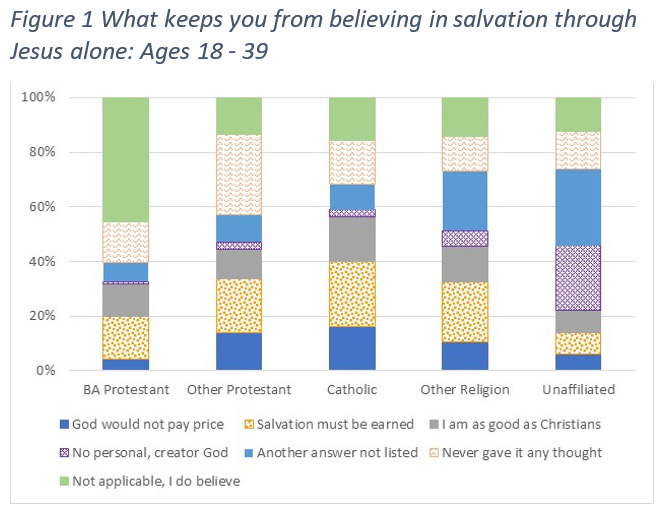
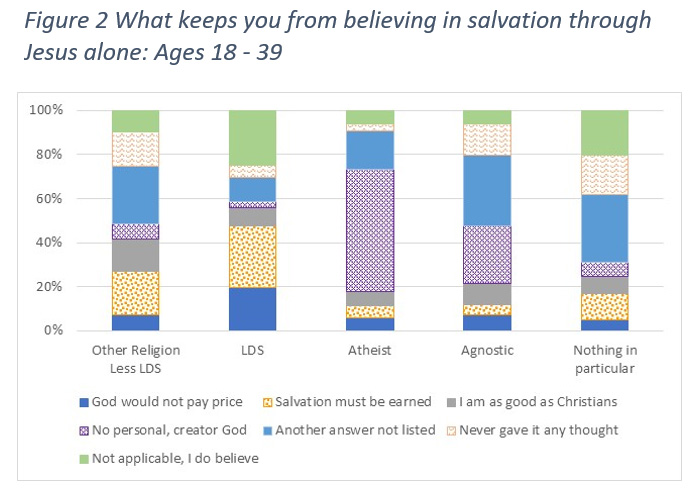 To get a better understanding of what drives these results, we dove further into the makeup of each of these two groups. The results are shown in Figure 2.
To get a better understanding of what drives these results, we dove further into the makeup of each of these two groups. The results are shown in Figure 2.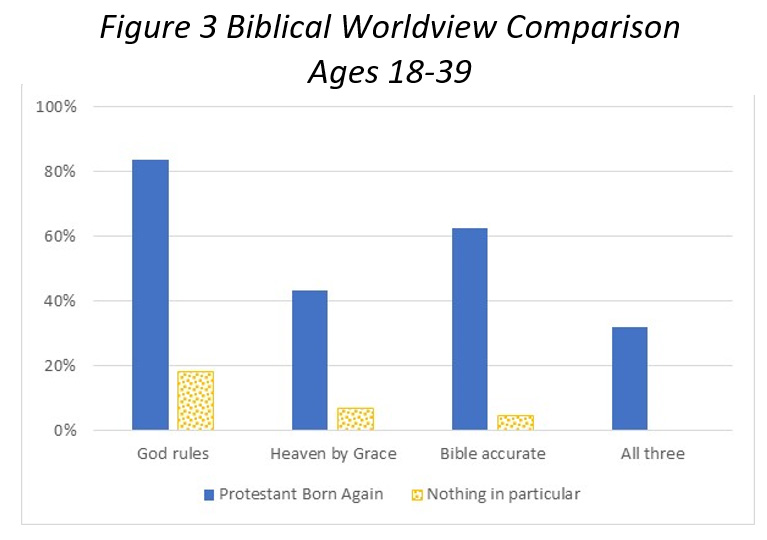 Let’s compare the results for Born-again Protestants and those who claimed to be Nothing in Particular. As shown in Figure 3, for each of the questions those agreeing with a biblical worldview among the Nothing in Particulars is a small fraction of those among Born-again Protestants. When we combine the three questions together, we see one out of three Born-again Protestants vs. no NIPs. Certainly, some of these NIPs came from an evangelical background, but none of them interviewed in our survey ascribe to a basic evangelical worldview as adults. As noted in our first report, one in three orn-again Protestants is a disappointing percentage ascribing to these biblical worldview questions, but it is certainly dramatically better than the Nothing in Particular group.
Let’s compare the results for Born-again Protestants and those who claimed to be Nothing in Particular. As shown in Figure 3, for each of the questions those agreeing with a biblical worldview among the Nothing in Particulars is a small fraction of those among Born-again Protestants. When we combine the three questions together, we see one out of three Born-again Protestants vs. no NIPs. Certainly, some of these NIPs came from an evangelical background, but none of them interviewed in our survey ascribe to a basic evangelical worldview as adults. As noted in our first report, one in three orn-again Protestants is a disappointing percentage ascribing to these biblical worldview questions, but it is certainly dramatically better than the Nothing in Particular group.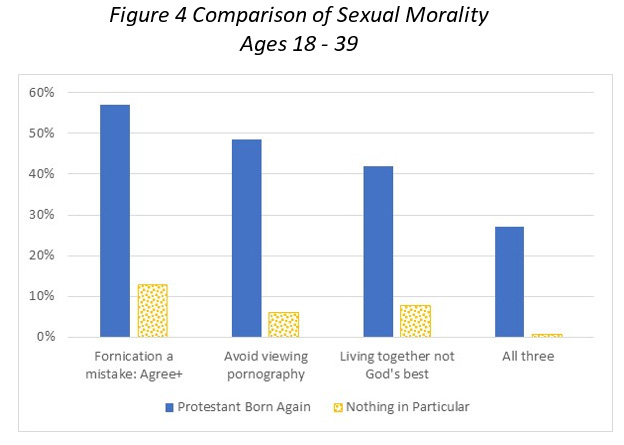 The results from our survey are shown in Figure 4. Once again, we see a large difference between these two groups. Clearly, the NIPs do not ascribe to a biblical view on sexual morality. The majority of Born-again Protestants do not ascribe to those beliefs either, but a significant minority of them do.
The results from our survey are shown in Figure 4. Once again, we see a large difference between these two groups. Clearly, the NIPs do not ascribe to a biblical view on sexual morality. The majority of Born-again Protestants do not ascribe to those beliefs either, but a significant minority of them do. Results from the first question are plotted in Figure 1. As shown, here and in the next three graphs, we will look at those ages 18 through 29 next to those ages 40 through 55 to see if there are differences based on age. If there is a trend or variation seen in the 30 through 39 age group, then that one is also shown as seen for Born Again Protestants in Figure 1.
Results from the first question are plotted in Figure 1. As shown, here and in the next three graphs, we will look at those ages 18 through 29 next to those ages 40 through 55 to see if there are differences based on age. If there is a trend or variation seen in the 30 through 39 age group, then that one is also shown as seen for Born Again Protestants in Figure 1. Pornography.
Pornography. The third question examines views on whether it is a good thing to live together in a sexual relationship before committing to marriage. The results are summarized in Figure 3. This is another question where Born Again Protestants show a significant difference based on age. The older group, 40 through 55, shows almost 60% who say that it should be avoided as instructed by God. The younger group, 18 through 29, shows only 40% with the same viewpoint. Across all age ranges only about one half of Born Again Protestants say that this practice should be avoided. So, even among this group, over half believe that it is okay and might be helpful.
The third question examines views on whether it is a good thing to live together in a sexual relationship before committing to marriage. The results are summarized in Figure 3. This is another question where Born Again Protestants show a significant difference based on age. The older group, 40 through 55, shows almost 60% who say that it should be avoided as instructed by God. The younger group, 18 through 29, shows only 40% with the same viewpoint. Across all age ranges only about one half of Born Again Protestants say that this practice should be avoided. So, even among this group, over half believe that it is okay and might be helpful. The verse above tells us two things. First, that someone who is given over to homosexual activity (like those given over to idolatry, sexual immorality, and greed) are not true followers of Christ. Even in Paul’s era, many were apparently saying they would inherit the kingdom of God and so Paul begins the statement by saying “Do not be deceived.” But it also clearly states that such a one can be washed, sanctified and justified in Jesus Christ. As Christians, we should love them and tell them the truth that God has a better way for their life.
The verse above tells us two things. First, that someone who is given over to homosexual activity (like those given over to idolatry, sexual immorality, and greed) are not true followers of Christ. Even in Paul’s era, many were apparently saying they would inherit the kingdom of God and so Paul begins the statement by saying “Do not be deceived.” But it also clearly states that such a one can be washed, sanctified and justified in Jesus Christ. As Christians, we should love them and tell them the truth that God has a better way for their life. Clearly, ones in the older group are more likely to take a biblical view on sexual behavior. In fact, on the far right, we see that those 40 to 55 are twice as likely as those 18 to 29 to hold to a biblical view. However, more important, is that over 80% of the younger ages and over 75% of the oldest ages do not hold to a biblical view on these combined topics regarding sexual behavior.
Clearly, ones in the older group are more likely to take a biblical view on sexual behavior. In fact, on the far right, we see that those 40 to 55 are twice as likely as those 18 to 29 to hold to a biblical view. However, more important, is that over 80% of the younger ages and over 75% of the oldest ages do not hold to a biblical view on these combined topics regarding sexual behavior. The first two answers are consistent with a Basic/Enhanced Biblical Worldview, reflecting 1) a view that their scripture is informed by a higher source of truth than simple science can draw upon, 2) a recognition that generally accepted scientific viewpoints have often changed over time, and 3) on the type of scientific questions being addressed here, there are in most cases a variety of theories supported by different groups of scientists. The second answer includes the possibility that the person’s holy scriptures do not directly address the topic at hand, but that some religious leaders have inferred a position on the topic from their interpretation of scriptures.
The first two answers are consistent with a Basic/Enhanced Biblical Worldview, reflecting 1) a view that their scripture is informed by a higher source of truth than simple science can draw upon, 2) a recognition that generally accepted scientific viewpoints have often changed over time, and 3) on the type of scientific questions being addressed here, there are in most cases a variety of theories supported by different groups of scientists. The second answer includes the possibility that the person’s holy scriptures do not directly address the topic at hand, but that some religious leaders have inferred a position on the topic from their interpretation of scriptures. Note these answers follow a similar pattern to those of the first question, but now they are applied to a specific question where many people assume there is no meeting ground between science and religion.
Note these answers follow a similar pattern to those of the first question, but now they are applied to a specific question where many people assume there is no meeting ground between science and religion. First note that if we strictly define real scientists as individuals meeting these qualifications—1) a Ph.D. in a scientific field, 2) actively involved in the field, and 3) published in reputable scientific journals—we will find many scientists who agree that there are other sources of truth outside of science. So, we can say with confidence that the statement in question #3 is objectively, verifiably not true. However, there are certainly some believers in scientism [the belief that science is the only way to know ultimate truth] who claim the statement is true. They accomplish this trick by claiming that anyone who does not believe that science is the only source of real truth cannot by definition be a real scientist.
First note that if we strictly define real scientists as individuals meeting these qualifications—1) a Ph.D. in a scientific field, 2) actively involved in the field, and 3) published in reputable scientific journals—we will find many scientists who agree that there are other sources of truth outside of science. So, we can say with confidence that the statement in question #3 is objectively, verifiably not true. However, there are certainly some believers in scientism [the belief that science is the only way to know ultimate truth] who claim the statement is true. They accomplish this trick by claiming that anyone who does not believe that science is the only source of real truth cannot by definition be a real scientist. What do the results look like when we combine these questions? In our opinion, there are a number of different answers that could be consistent with a biblical worldview. Starting with the strictest view of relying on the Bible rather than science and then adding in those who would look at the results from science to obtain a clearer understanding of what the Bible teaches or those areas where the Bible is silent. Then, we add in their view on scientism which as already discussed is demonstrated by a long list of scientists who disagree to be false, thus being a source of strong disagreement.
What do the results look like when we combine these questions? In our opinion, there are a number of different answers that could be consistent with a biblical worldview. Starting with the strictest view of relying on the Bible rather than science and then adding in those who would look at the results from science to obtain a clearer understanding of what the Bible teaches or those areas where the Bible is silent. Then, we add in their view on scientism which as already discussed is demonstrated by a long list of scientists who disagree to be false, thus being a source of strong disagreement. A natural question to ask is, “Does having a Basic Biblical Worldview correlate with having a biblical view on these science issues?” We can look at this question by comparing Born Again Protestants with a Basic Biblical Worldview with Born Again Protestants without a Basic BWV. The results are shown in the adjacent figure.
A natural question to ask is, “Does having a Basic Biblical Worldview correlate with having a biblical view on these science issues?” We can look at this question by comparing Born Again Protestants with a Basic Biblical Worldview with Born Again Protestants without a Basic BWV. The results are shown in the adjacent figure.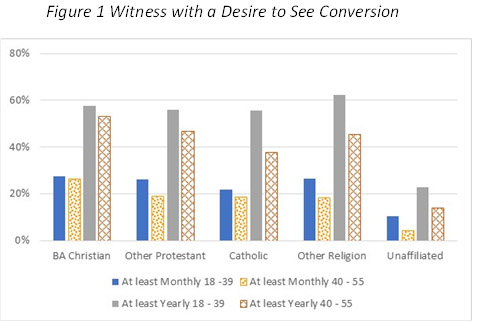 Looking at the detailed results, all religions except the Unaffiliated showed very similar results: over 20% (1 in 5) of those witnessed at least monthly and about half witnessed at least yearly. So, it would appear that there is a lot of witnessing going on with very few conversions.
Looking at the detailed results, all religions except the Unaffiliated showed very similar results: over 20% (1 in 5) of those witnessed at least monthly and about half witnessed at least yearly. So, it would appear that there is a lot of witnessing going on with very few conversions.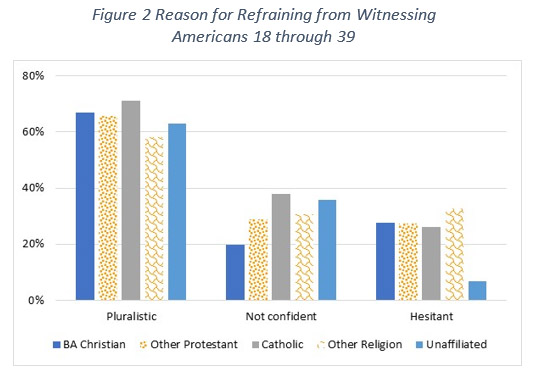 We also asked the question: “When I refrain from communicating my religious belief with someone, it’s usually because:”
We also asked the question: “When I refrain from communicating my religious belief with someone, it’s usually because:”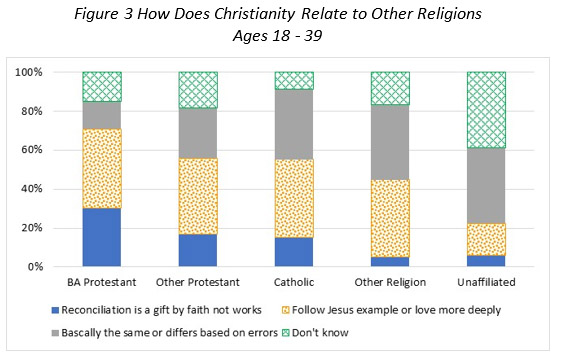 The results are charted in the graph to the right. First, notice the interesting result that only about 30% of Born Again Protestants selected ‘reconciliation is a gift’ while 40% selected following Jesus’ example or love others more deeply. As noted above, this second answer is not inconsistent with the concepts of Christianity but is not as fundamental as the first. However, selecting this answer over reconciliation is a gift’ is consistent with what we saw earlier: 70% of Born Again Christians are not exclusivists.
The results are charted in the graph to the right. First, notice the interesting result that only about 30% of Born Again Protestants selected ‘reconciliation is a gift’ while 40% selected following Jesus’ example or love others more deeply. As noted above, this second answer is not inconsistent with the concepts of Christianity but is not as fundamental as the first. However, selecting this answer over reconciliation is a gift’ is consistent with what we saw earlier: 70% of Born Again Christians are not exclusivists.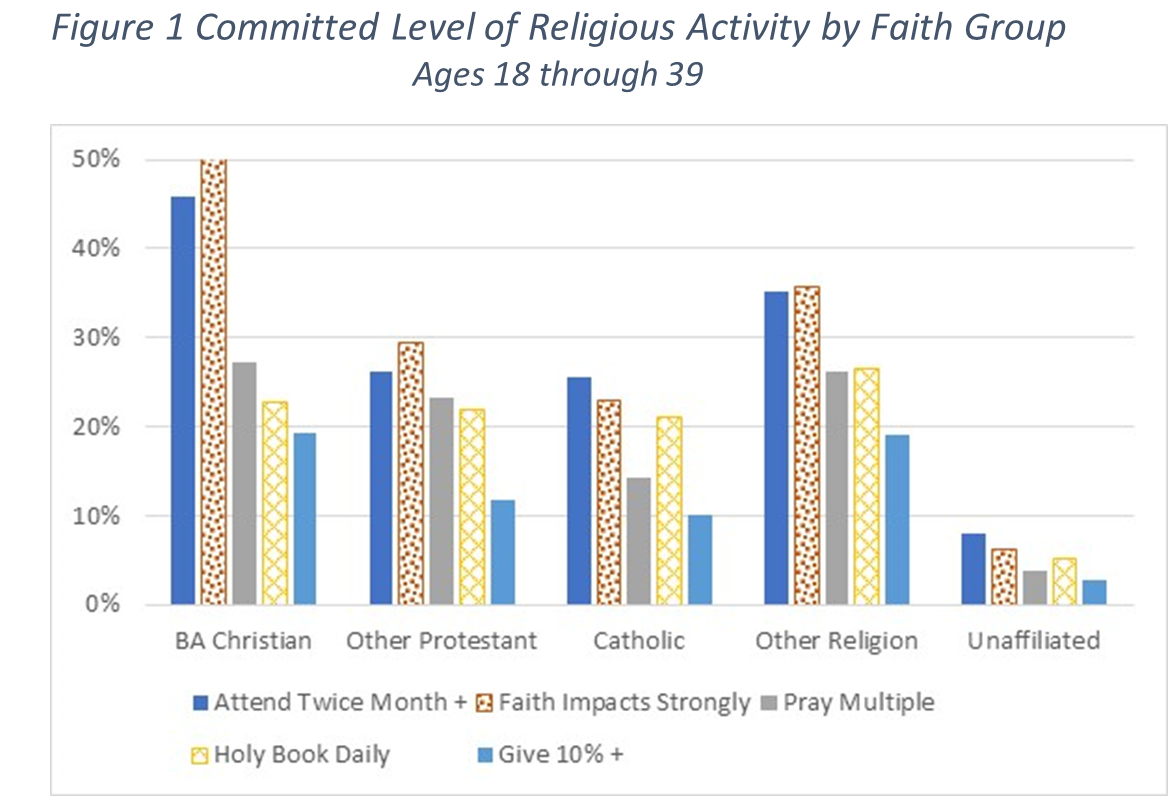
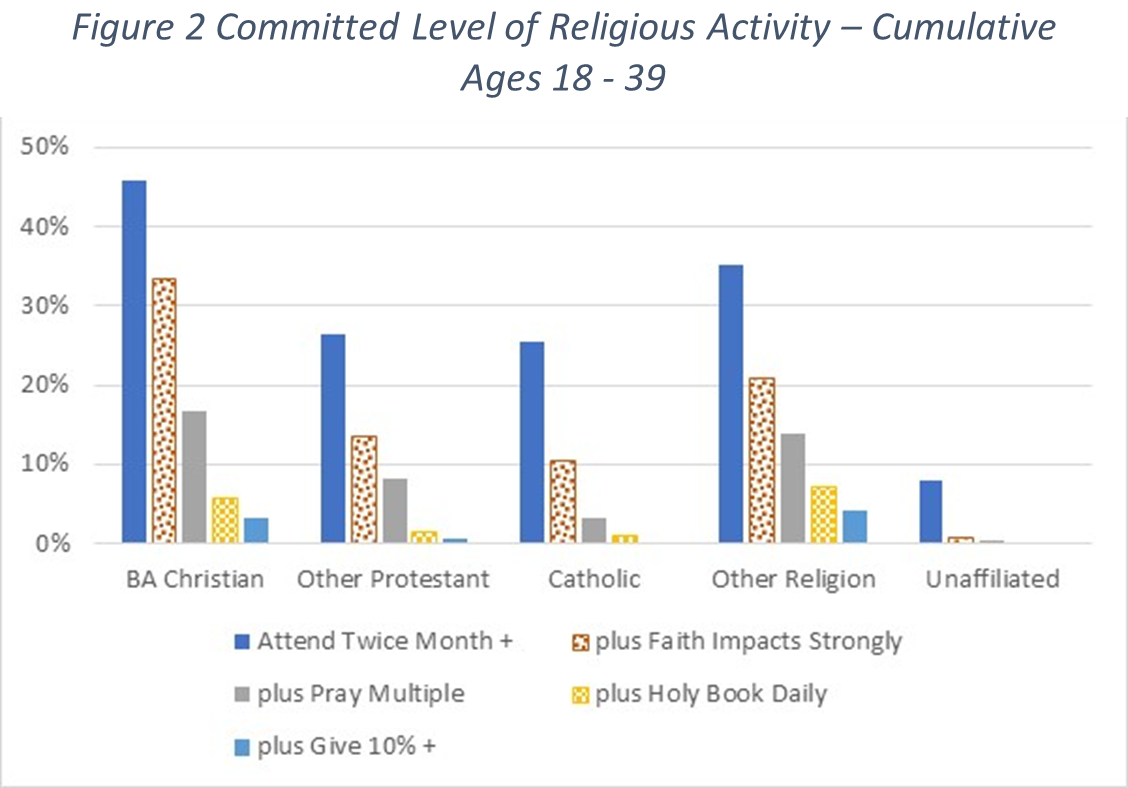
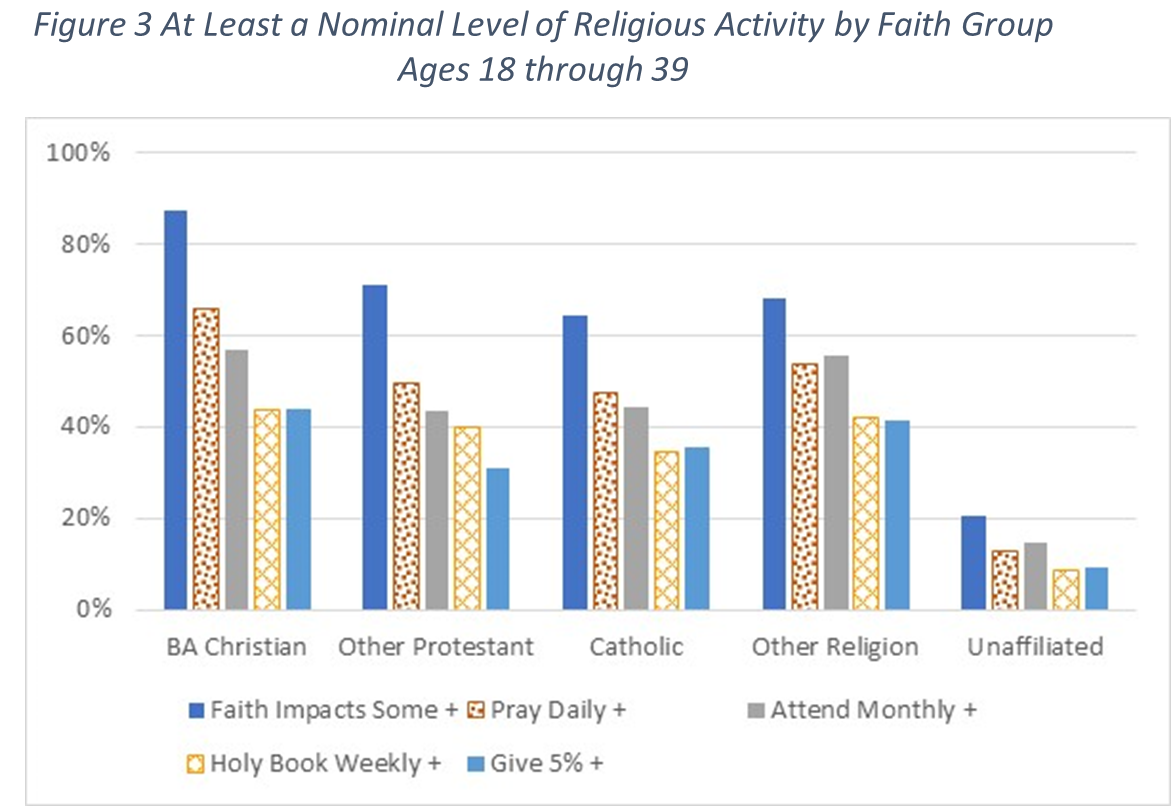 Nominal or Committed Levels of Religious Activity
Nominal or Committed Levels of Religious Activity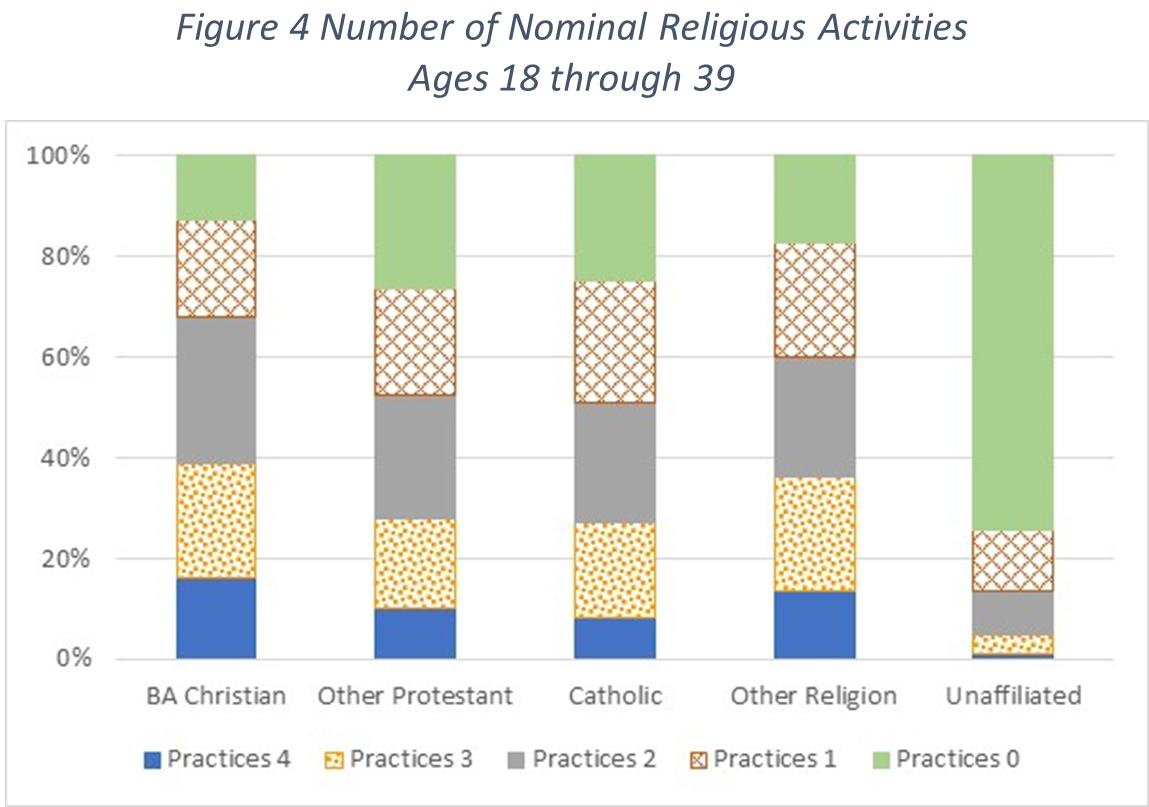
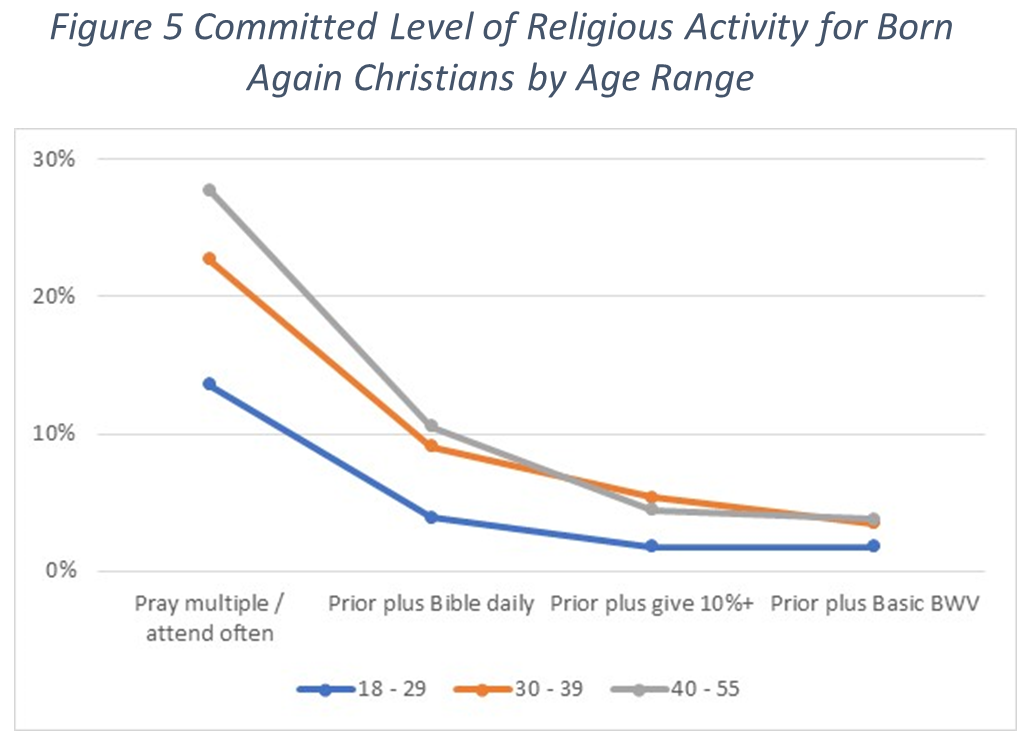
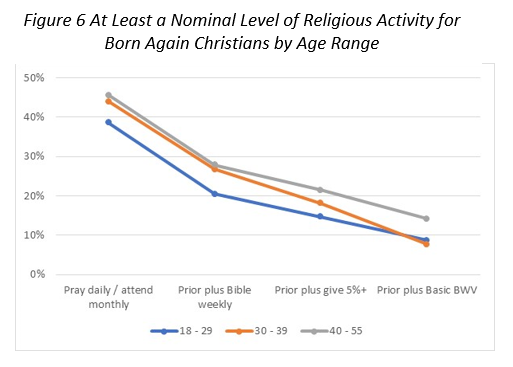
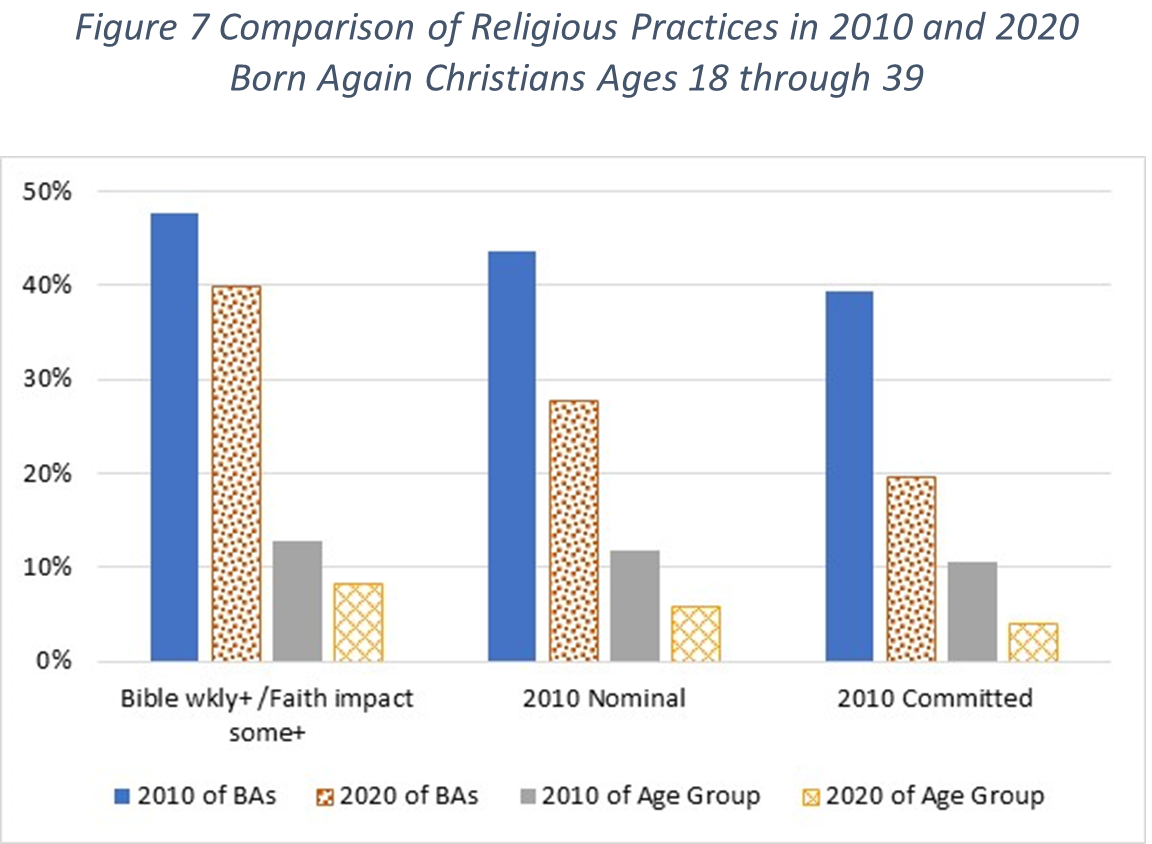
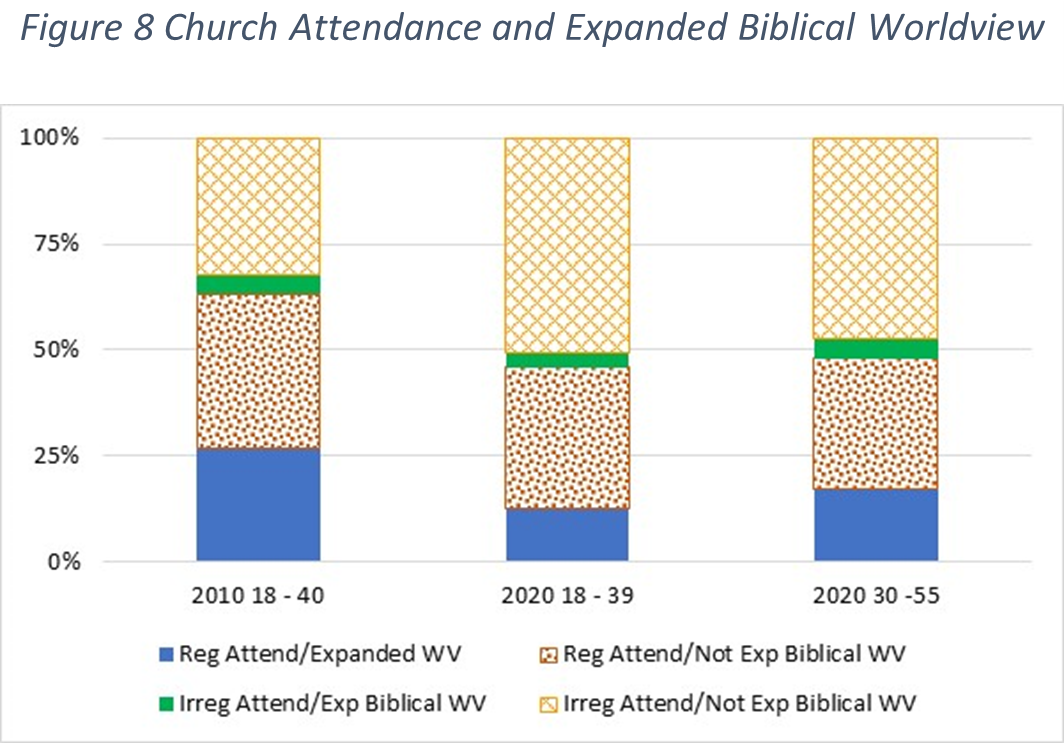 The figure on the left compares the findings from 2010 with those from 2020 using the more stringent Expanded Biblical Worldview. The values shown are the percent of Born-Again Christians (so all columns add up to 100% even though the percentage of Born Again Christians is less in 2020). Two age ranges are used in 2020; the first one is basically the same age range used in 2010 (18 – 39) and the second age range (30 – 55) is very close to the age range of the 2010 survey aged by the ten years that have gone by.
The figure on the left compares the findings from 2010 with those from 2020 using the more stringent Expanded Biblical Worldview. The values shown are the percent of Born-Again Christians (so all columns add up to 100% even though the percentage of Born Again Christians is less in 2020). Two age ranges are used in 2020; the first one is basically the same age range used in 2010 (18 – 39) and the second age range (30 – 55) is very close to the age range of the 2010 survey aged by the ten years that have gone by.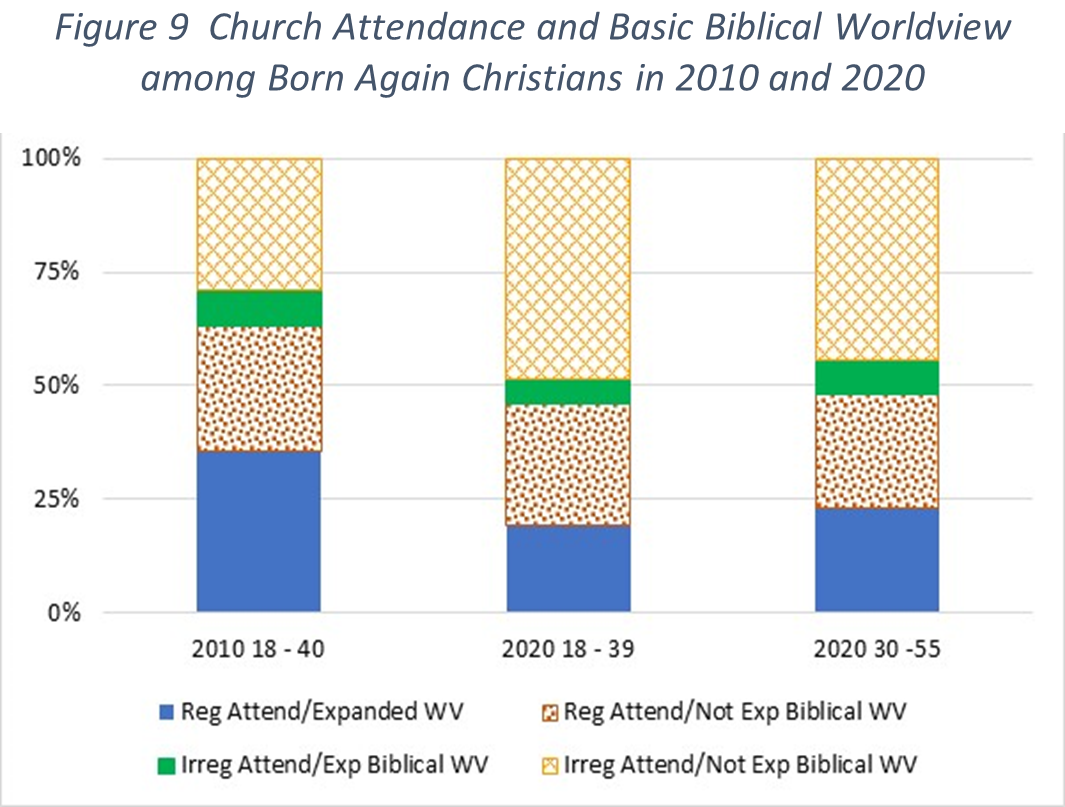 Now let’s examine the same chart using a Basic Biblical Worldview. We see nearly the same features as discussed above. A significant drop is shown in those with regular attendance and a Basic Biblical Worldview coupled with a significant increase in those with irregular attendance and no Basic Biblical Worldview.
Now let’s examine the same chart using a Basic Biblical Worldview. We see nearly the same features as discussed above. A significant drop is shown in those with regular attendance and a Basic Biblical Worldview coupled with a significant increase in those with irregular attendance and no Basic Biblical Worldview.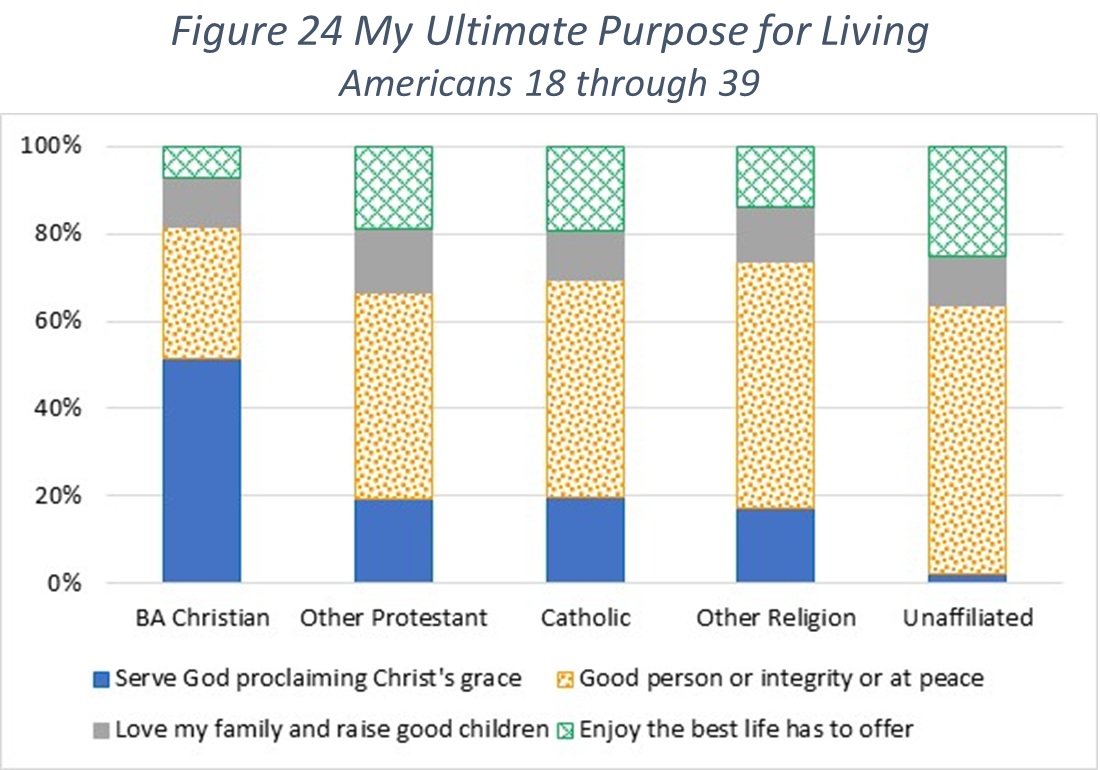 The results are charted in the graph to the left. As shown, just over half of Born Again Christians profess an eternal perspective. This means almost half do not, with most of those selecting a purpose that focuses on good behaviors in their personal life.
The results are charted in the graph to the left. As shown, just over half of Born Again Christians profess an eternal perspective. This means almost half do not, with most of those selecting a purpose that focuses on good behaviors in their personal life.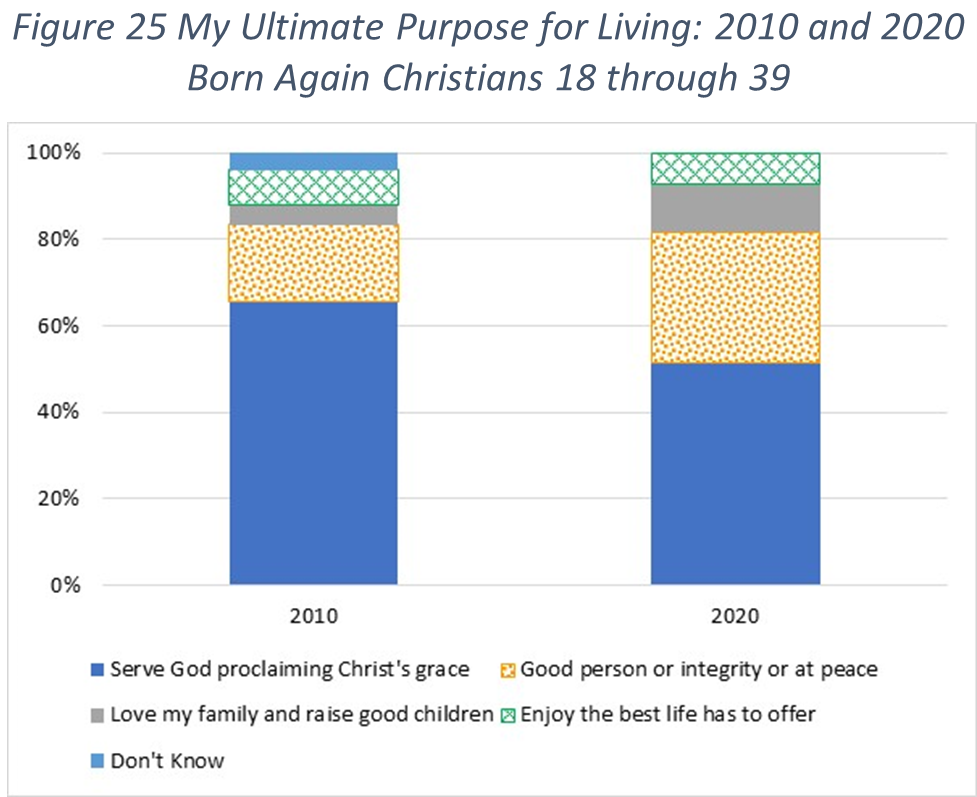
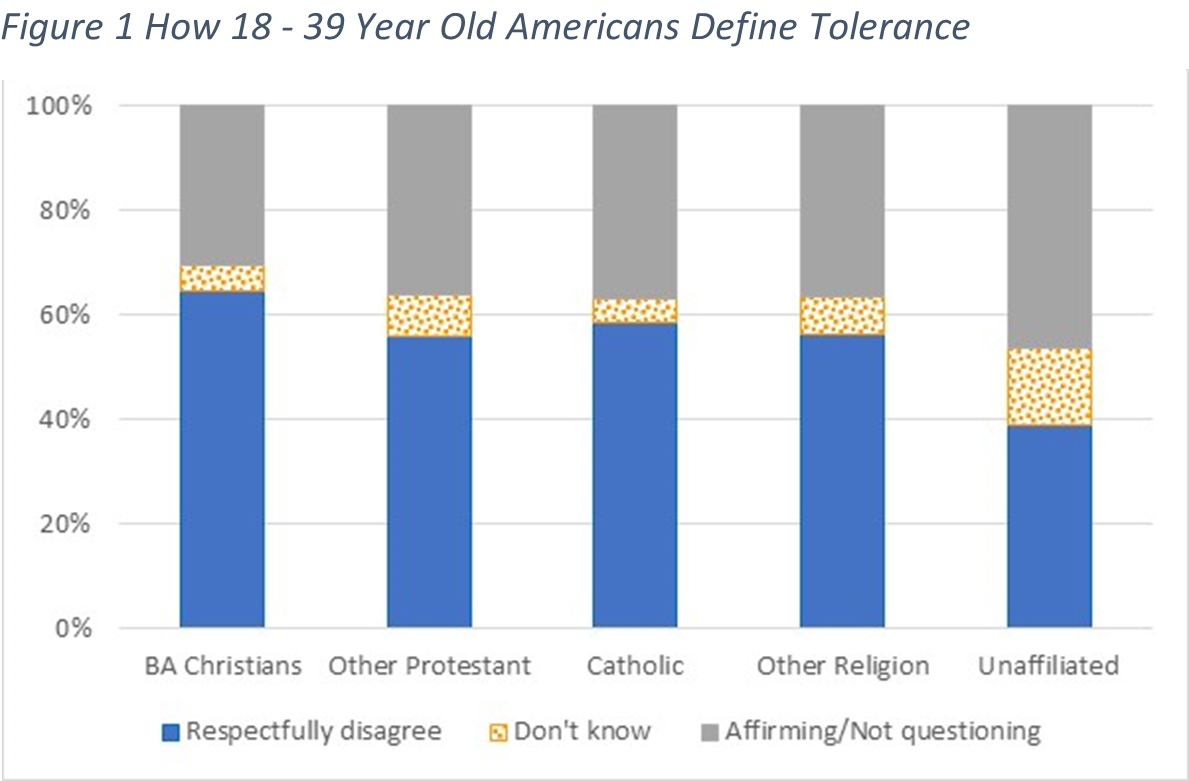
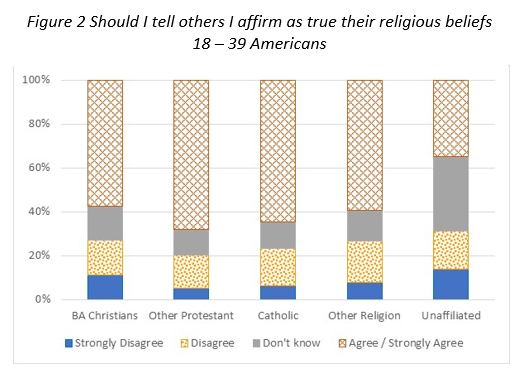
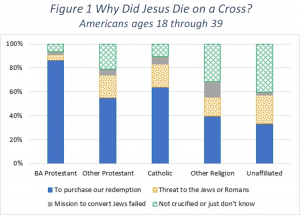 The responses for ages 18 through 39 are shown in Figure 1. As shown, Born Again Protestants have a far greater percentage, over 85%, stating that Jesus was crucified to purchase our redemption. One would suspect that all Protestant and Catholic leaders would want their people to know that Jesus’ death on the cross was for their redemption. Yet, less than two thirds of each group selected that answer. Note that the answer to this question did not say that salvation was through grace alone. So even those with a works-based gospel should still select that answer.
The responses for ages 18 through 39 are shown in Figure 1. As shown, Born Again Protestants have a far greater percentage, over 85%, stating that Jesus was crucified to purchase our redemption. One would suspect that all Protestant and Catholic leaders would want their people to know that Jesus’ death on the cross was for their redemption. Yet, less than two thirds of each group selected that answer. Note that the answer to this question did not say that salvation was through grace alone. So even those with a works-based gospel should still select that answer.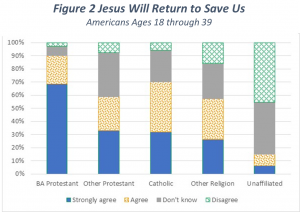 The results for this question follow a similar pattern to those for the first question above with a little less surety shown among Christians. As shown, just over two thirds of Born Again Protestants strongly agree that Jesus will return to save. Meaning that almost one third of them are not absolutely sure of Jesus’ return.
The results for this question follow a similar pattern to those for the first question above with a little less surety shown among Christians. As shown, just over two thirds of Born Again Protestants strongly agree that Jesus will return to save. Meaning that almost one third of them are not absolutely sure of Jesus’ return.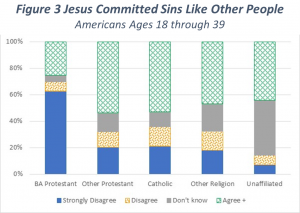 Young adult American beliefs about this statement follow a similar pattern as the first two questions. Once again, about one third of Born Again Protestants either Don’t Know or Agree with this statement. Having this large a number of Born Again Protestants who don’t accept a primary belief of Biblical Christianity is disappointing.
Young adult American beliefs about this statement follow a similar pattern as the first two questions. Once again, about one third of Born Again Protestants either Don’t Know or Agree with this statement. Having this large a number of Born Again Protestants who don’t accept a primary belief of Biblical Christianity is disappointing.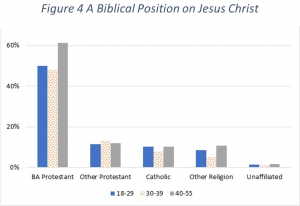 What happens when we look at how many Born Again Protestants take a biblically consistent view on all three of these questions? Consider the results shown in Figure 4. First, we see that young adult Born Again Protestants drop from about two thirds for the individual questions down to about one half when looking at all three questions. It appears that about one half of those categorized as Born Again Protestants are trusting Jesus to save them but do not have a good understanding of biblical teaching on Jesus.
What happens when we look at how many Born Again Protestants take a biblically consistent view on all three of these questions? Consider the results shown in Figure 4. First, we see that young adult Born Again Protestants drop from about two thirds for the individual questions down to about one half when looking at all three questions. It appears that about one half of those categorized as Born Again Protestants are trusting Jesus to save them but do not have a good understanding of biblical teaching on Jesus.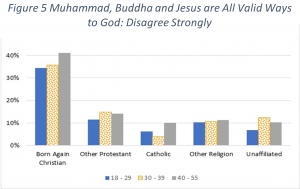 First let’s look at just question number one across the various religious groups, looking for the answer Disagree strongly as shown in Figure 5
First let’s look at just question number one across the various religious groups, looking for the answer Disagree strongly as shown in Figure 5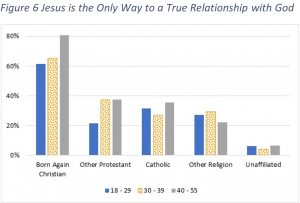 Instead, we asked this second question in a slightly different way but with the same intent: “I believe that the only way to a true relationship with God is through Jesus Christ.” We thought that this question would be
Instead, we asked this second question in a slightly different way but with the same intent: “I believe that the only way to a true relationship with God is through Jesus Christ.” We thought that this question would be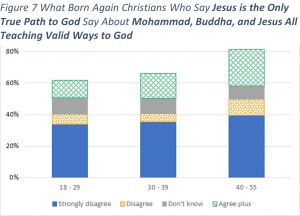 However, the survey respondents show us that one does not have to give answers which logically support one another. Even if some of the respondents misread the statement, the difference between the two is great enough that it is safe to assume that the results are not primarily attributable to misreading.
However, the survey respondents show us that one does not have to give answers which logically support one another. Even if some of the respondents misread the statement, the difference between the two is great enough that it is safe to assume that the results are not primarily attributable to misreading.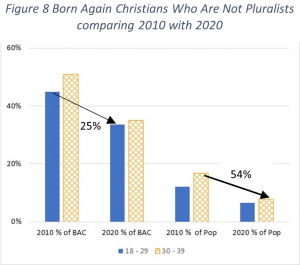 How have the statistics on Born Again Christians and pluralism changed from 2010 to 2020? As shown in the figure, we see a significant drop in the percent of BACs who are not pluralists. Those age 18 to 29 drop by 25% (from 45% to 34% of all BACs) and those age 30 to 39 drop by 31% (from 51% to 35% of all BACs).
How have the statistics on Born Again Christians and pluralism changed from 2010 to 2020? As shown in the figure, we see a significant drop in the percent of BACs who are not pluralists. Those age 18 to 29 drop by 25% (from 45% to 34% of all BACs) and those age 30 to 39 drop by 31% (from 51% to 35% of all BACs).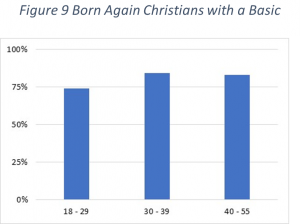 What about that smaller subset of people who have a Basic Biblical Worldview? Do a majority of them also have a pluralistic worldview? The answer is no. As shown, between 75% and 85% of them are not pluralists.
What about that smaller subset of people who have a Basic Biblical Worldview? Do a majority of them also have a pluralistic worldview? The answer is no. As shown, between 75% and 85% of them are not pluralists.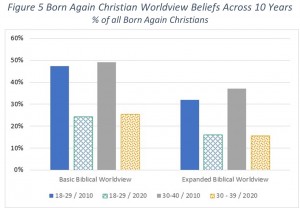 Now let’s compare these 2020 results with the results from our 2010 survey. Figure 5 shows the results across this decade for Born Again Christians looking at the percent who agree with the worldview answers above. As shown, there has been a dramatic drop in both the Basic Biblical Worldview and the Expanded Biblical Worldview.
Now let’s compare these 2020 results with the results from our 2010 survey. Figure 5 shows the results across this decade for Born Again Christians looking at the percent who agree with the worldview answers above. As shown, there has been a dramatic drop in both the Basic Biblical Worldview and the Expanded Biblical Worldview.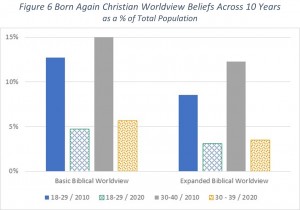 However, because the percent of the population who profess to being born again has dropped over the last ten years as well, the situation is even worse. We need to look at the percent of Americans of a particular age range who hold to a Biblical Worldview. Those results are shown in Figure 6. Once again, comparing the 18–29 age group from 2010 with the same age group ten years later now 30–39, we find an even greater drop off. For the Basic Biblical Worldview, we see a drop off from 13% of the population down to 6%. For the Expanded Biblical Worldview, the decline is from 9% down to just over 3% (a drop off of two thirds).
However, because the percent of the population who profess to being born again has dropped over the last ten years as well, the situation is even worse. We need to look at the percent of Americans of a particular age range who hold to a Biblical Worldview. Those results are shown in Figure 6. Once again, comparing the 18–29 age group from 2010 with the same age group ten years later now 30–39, we find an even greater drop off. For the Basic Biblical Worldview, we see a drop off from 13% of the population down to 6%. For the Expanded Biblical Worldview, the decline is from 9% down to just over 3% (a drop off of two thirds).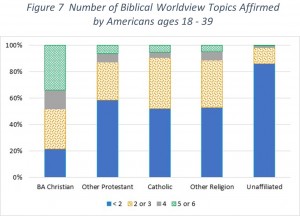 Rather than look at the two biblical worldview levels discussed above, we will look at how many of the six biblical worldview questions they answered were consistent with a biblical worldview. In the chart, we look at 18- to 39-year-old individuals grouped by religious affiliation and map what portion answered less than two of the questions biblically, two or three, four, or more than four (i.e., five or six).
Rather than look at the two biblical worldview levels discussed above, we will look at how many of the six biblical worldview questions they answered were consistent with a biblical worldview. In the chart, we look at 18- to 39-year-old individuals grouped by religious affiliation and map what portion answered less than two of the questions biblically, two or three, four, or more than four (i.e., five or six).